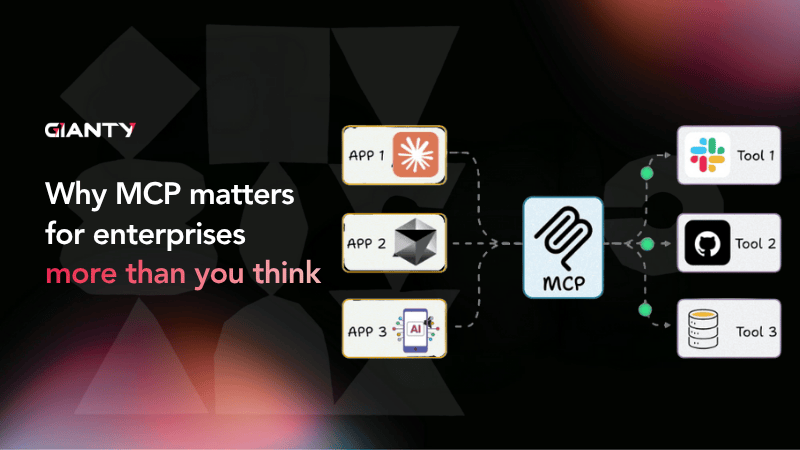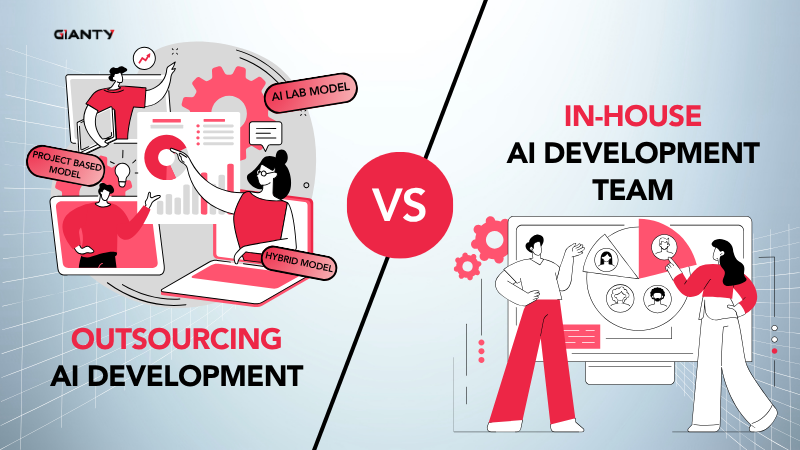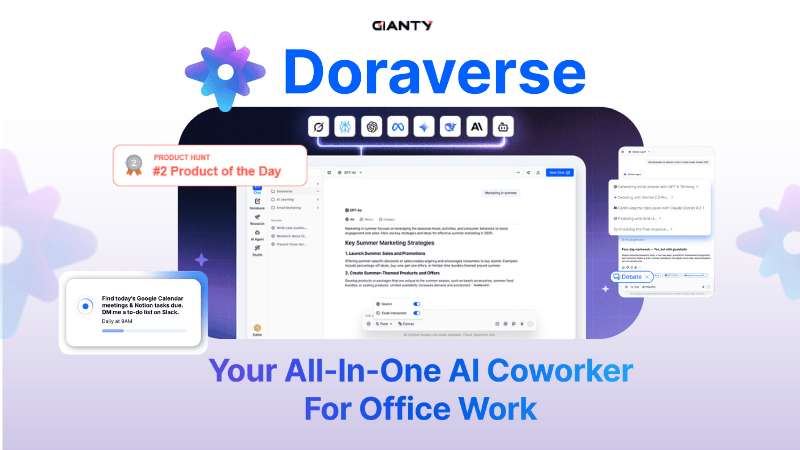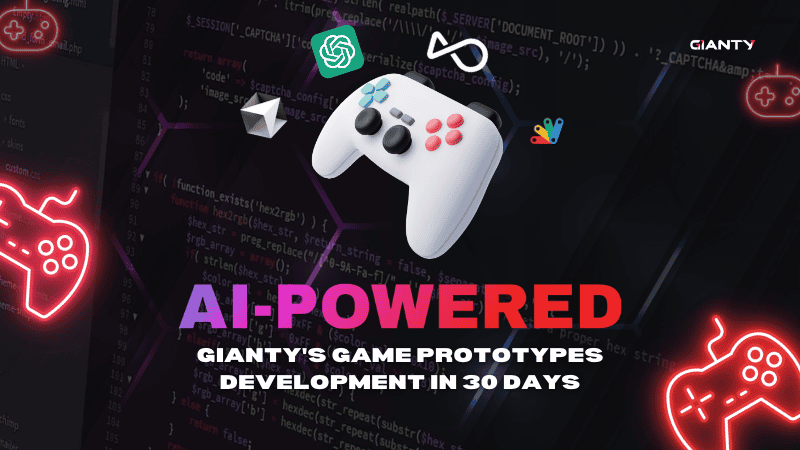Artificial intelligence (AI) is transforming how businesses operate. Specifically, AI agents are experiencing a significant transformation, moving from manual programming to no-code platforms. For tech enterprises, these agents are at the forefront of this revolution, automating tasks, analyzing data, and enhancing decision-making, which drives efficiency and competitive advantage.
However, when it comes to choosing the most suitable AI agent platform, we encounter two major options: no-code vs. pro-code AI platforms. Each approach has distinct strengths, and choosing the right one depends on your project’s complexity, resources, and timeline.
This article compares code-based and no-code approaches, offering insights for business and technical leaders, while highlighting how a hybrid strategy, blending the speed of no-code with the flexibility of code, often delivers the optimal balance for building AI agents that scale and innovate.
Understanding AI Agents
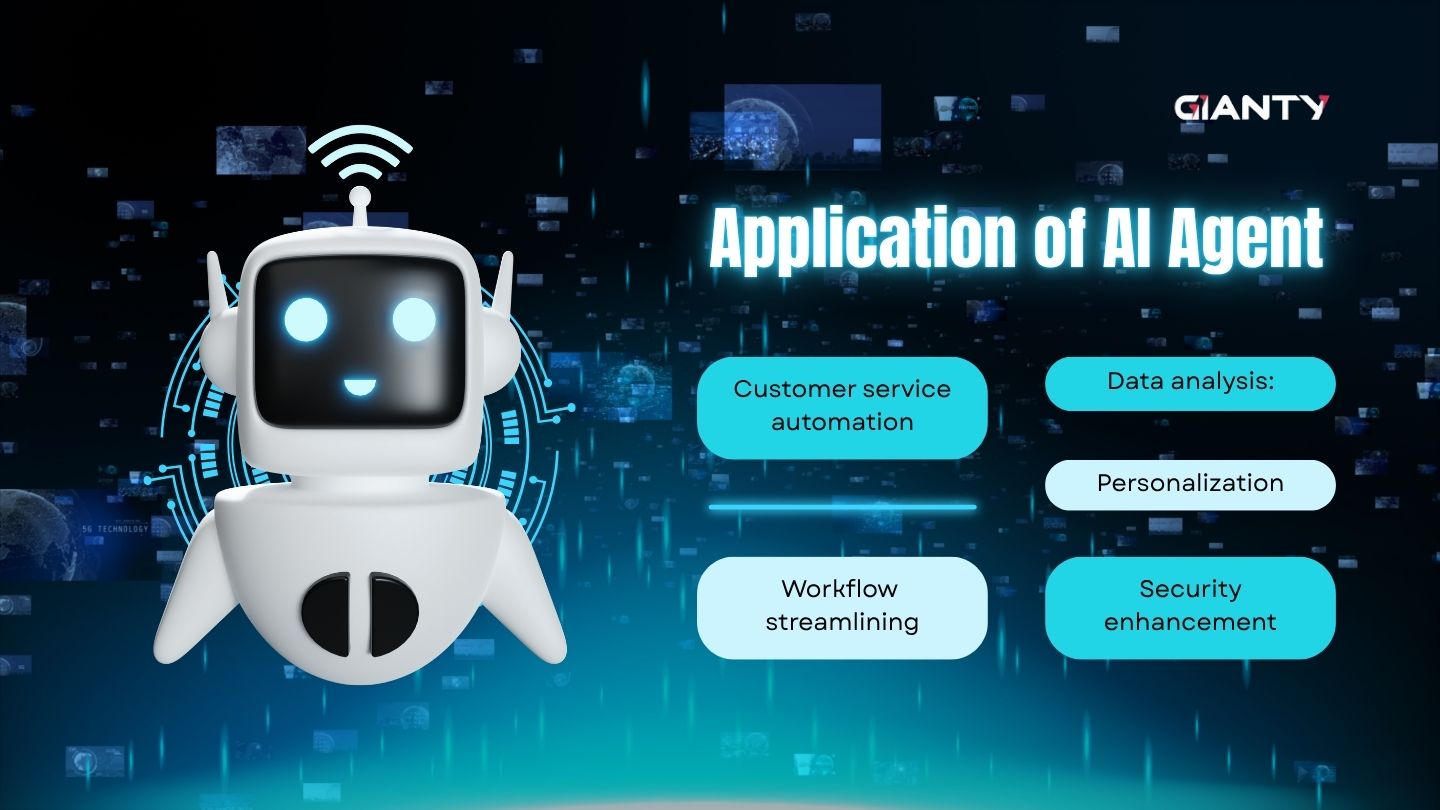
At their core, AI agents are autonomous or semi-autonomous software programs that operate independently, using AI technologies to perform tasks with minimal human intervention. They leverage capabilities like natural language processing (NLP), machine learning (ML), and large language models (LLMs) to interact with their environment and deliver value. In the tech industry, AI agents are deployed across various applications:
- Customer service automation: Chatbots handle routine inquiries, escalating complex issues to human agents.
- Data analysis: Agents process large datasets to uncover actionable insights, such as market trends or customer behavior.
- Workflow streamlining: Automating repetitive tasks like scheduling, data entry, or invoice processing.
- Security enhancement: Detecting anomalies to strengthen cybersecurity measures.
- Personalization: Tailoring user experiences based on behavioral data and enhancing engagement.
The decision to build these agents using code-based or no-code platforms depends on factors like technical expertise, project scope, and deployment speed. Understanding these options is key to aligning your AI strategy with business goals.
Code-Based AI Agents Platforms
Traditional code-based platforms require developers to manage all aspects of development by writing custom code in programming languages such as Python, Java, or C++. They also utilize associated libraries like TensorFlow, PyTorch, or LangChain to build AI agents from scratch. These platforms provide granular control, making them ideal for creating complex and tailored solutions.
Code-based AI agents have several key capabilities. They can operate as multi-agent systems, utilizing planning and memory features to improve their performance. Additionally, they support various toolchains and API integrations, allowing for seamless communication with other software. Furthermore, these agents can leverage custom large language models (LLMs) tailored to specific needs, and they can implement specialized business logic to meet unique requirements.
Several applications of code-based platforms include code generation and assistance, automated code review and debugging, as well as providing support for IT service desk operations.
Advantages of Code-based:
- Unmatched customization: Since developers can fully control the development process, they can custom-make AI agents to meet specific enterprise needs.
- Scalability: Code-based agents excel at handling large datasets and complex computations, perfect for enterprise-grade applications.
- High flexibility: They integrate effortlessly with existing systems, APIs, and databases, ensuring compatibility with your tech stack.
Disadvantages of Code-based:
- Expertise required: Building and maintaining these agents demands skilled developers, which can be a barrier for dev-light enterprises.
- Time-intensive: Coding, debugging, and testing extend development timelines, delaying deployment.
- Higher costs: Hiring specialized talent and longer development cycles increase initial investment.
No-Code Platforms for AI Agents
Unlike code-based, no-code platforms allow you to build and customize AI agents without any coding. They empower users to create AI agents only by using visual interfaces, drag-and-drop tools, and pre-built templates. These platforms simplify AI development, enabling non-technical teams to contribute.
No-code AI agents possess capabilities such as task automation, data processing and analysis, as well as natural language understanding and generation. As a result, several applications of no-code platforms include slackbots, social content generator, invoice processing, and customer service FAQ bots.
Some examples of no-code tools are n8n.io, Make, Zapier, Relevance AI.
Advantages of No-code:
- Rapid development: No-code platforms can reduce development time by up to 90%, enabling quick prototyping and deployment (AIMultiple).
- Ease of accessibility: Non-developers can build, manage and revise workflows, allowing engineering teams to focus on more complex tasks.
- Cost-effective: Lower initial costs by reducing reliance on developers, ideal for startups or smaller projects.
Disadvantages of No-code:
- Limited customization: Pre-built components restrict complex logic or highly specialized agents, which limit flexibility.
- Platform dependency: Enterprises are tied to the platform’s capabilities and updates, which may not evolve with project needs.
- Scalability constraints: Less suited for large-scale or complex applications due to performance limitations.
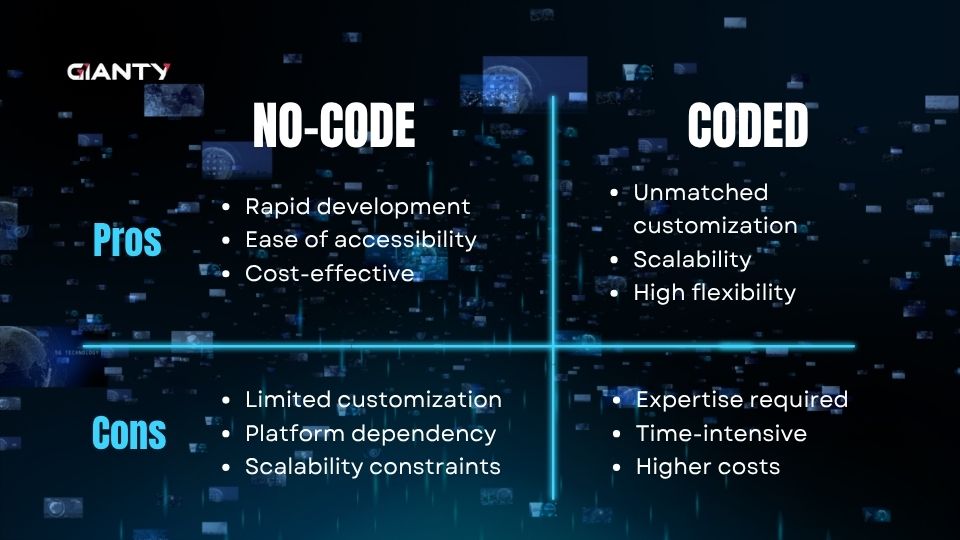
Comparing Code-Based and No-Code Approaches
To guide decision-makers, the following table compares code-based and no-code platforms across key features relevant to AI agent development:
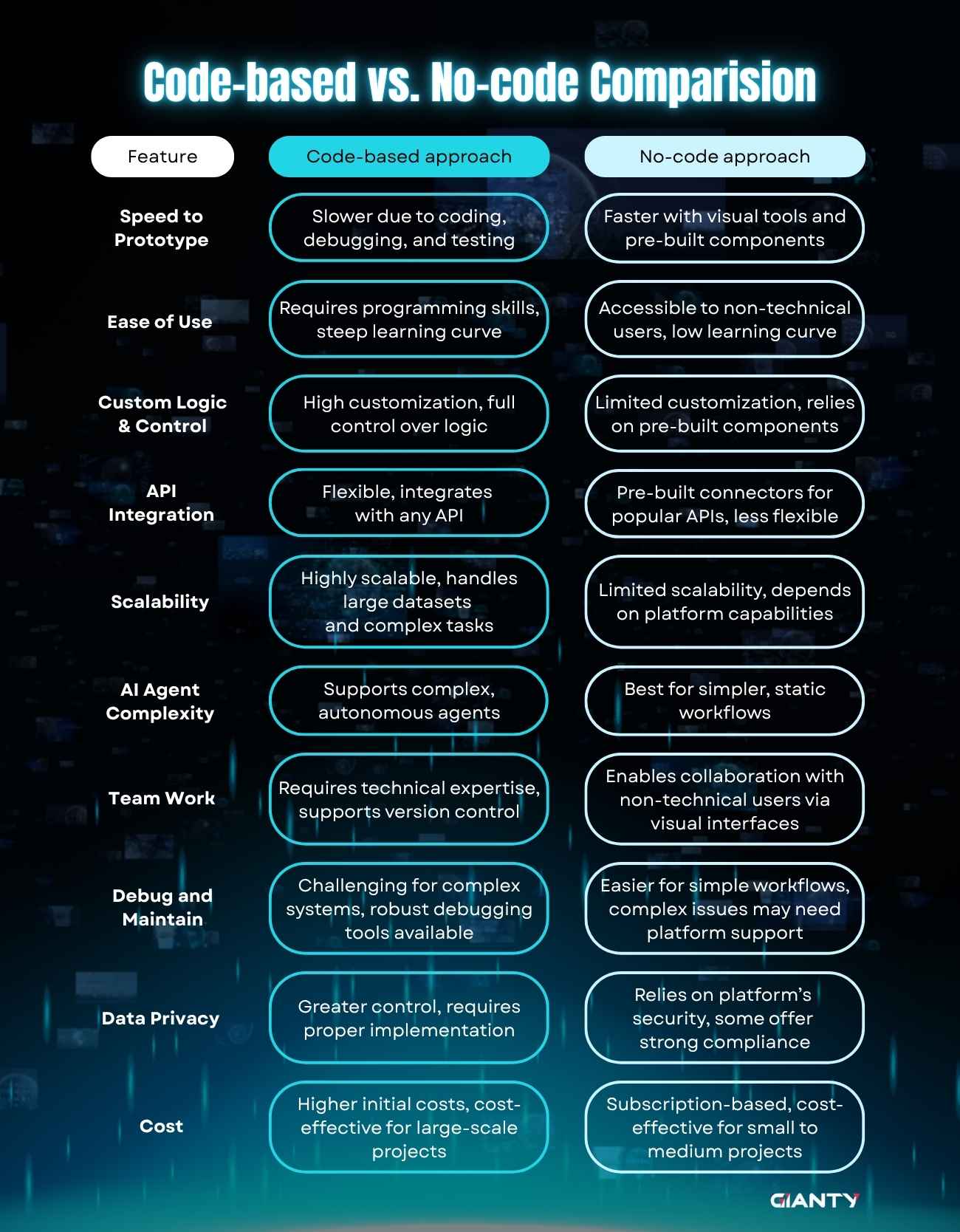
This comparison underscores that no-code platforms prioritize speed and accessibility, while code-based approaches excel in flexibility and scalability.
When to Use Each Approach
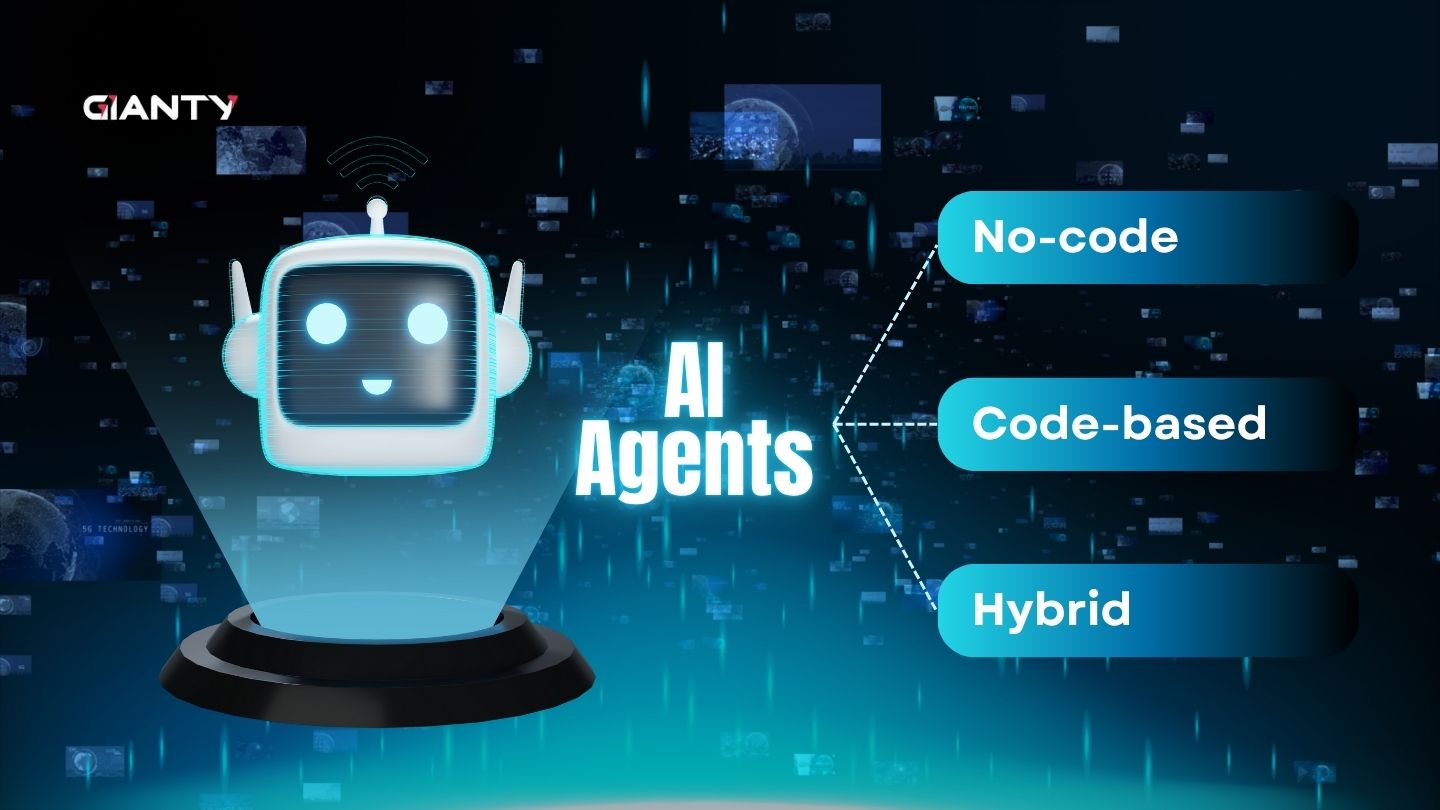
At this point, we trust that you have a good understanding of the differences between no-code and pro-code AI platforms. Indeed, making a decision between no-code and pro-code AI agents involves considering several important factors, like your project’s goals, resources, and timeline, to ensure a smart selection.
Here’s a breakdown to guide your decision:
Use No-Code when:
- Speed is critical: Ideal for rapid prototyping, minimum viable products (MVPs), or projects with tight deadlines, such as launching a customer service chatbot.
- Technical resources are limited: Perfect for dev-light enterprises or teams without dedicated developers, enabling business users to create AI agents.
- Use cases are simple to moderate: Suited for tasks like Slack integrations, automated content flows, or basic AI-driven summarization.
Use Code when:
- Workflows are complex: Best for multi-agent systems, advanced reasoning, or custom machine learning models requiring intricate logic.
- Custom datasets are involved: Ideal for building products, APIs, or large-scale infrastructure with proprietary data.
- Long-term flexibility is needed: When vendor independence and scalability are priorities, such as for SaaS companies scaling their offerings.
The hybrid approach: The smartest strategy
For many tech enterprises, a hybrid approach—combining no-code’s speed with code’s flexibility—offers the best of both worlds. This strategy leverages no-code platforms for rapid prototyping and routine tasks, while incorporating custom code for advanced features, complex logic, or scalability. For example, a SaaS company might use n8n to quickly build a workflow automation agent, then integrate custom Python code for specialized data processing.
Benefits of a hybrid approach:
- Optimized speed and flexibility: No-code accelerates initial development, while code enables tailored enhancements.
- Iterative development: Start with no-code for MVPs, then transition to code for production-ready solutions, streamlining the development cycle.
- Resource efficiency: Allocate technical expertise to high-impact tasks while using no-code for simpler workflows, maximizing team productivity.
This approach is particularly valuable for AI-centric startups testing innovative ideas quickly, established SaaS companies balancing speed and customization, and dev-light enterprises seeking to innovate without heavy developer investment.
Future Trends in AI Agent Development
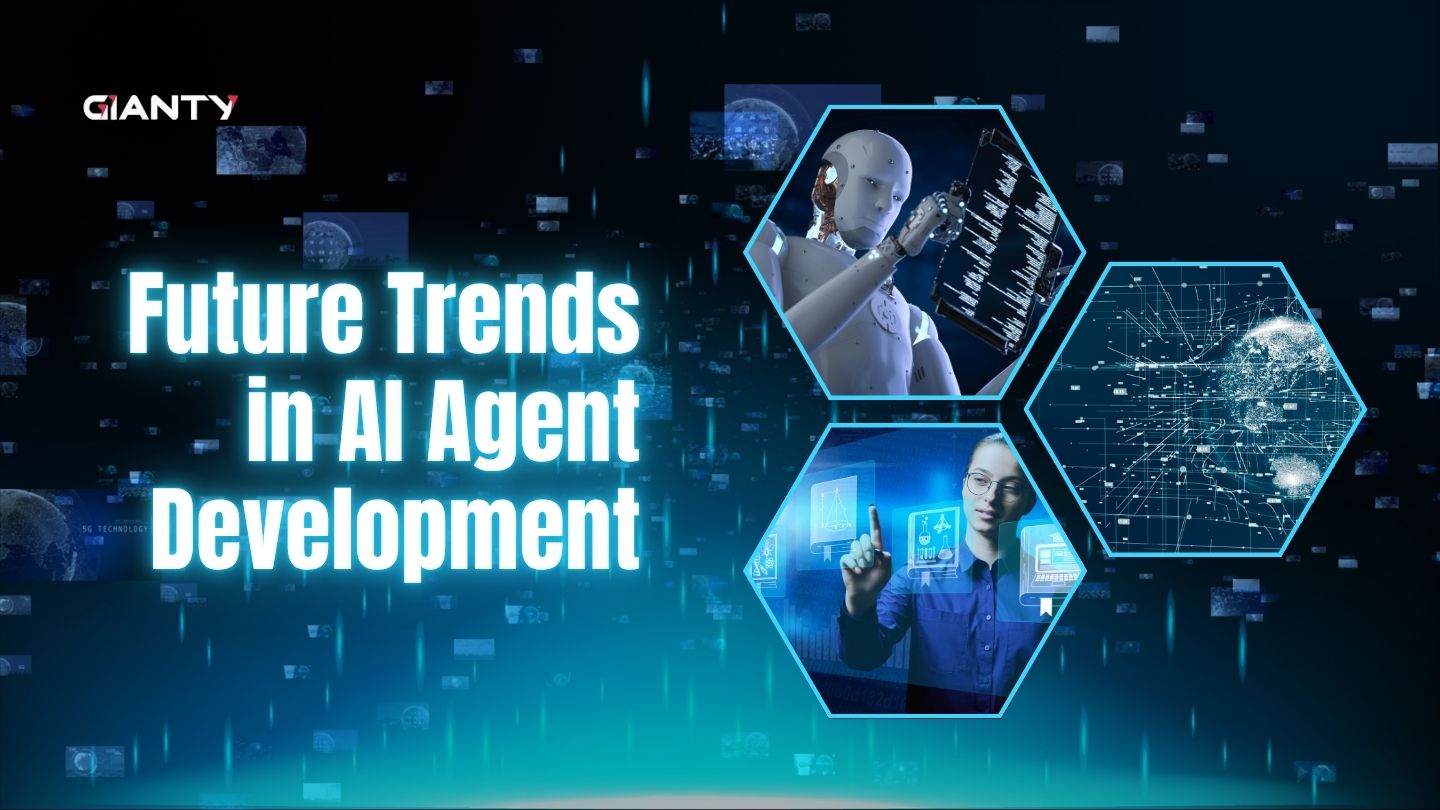
The landscape of AI agent development is evolving rapidly. No-code platforms are becoming more sophisticated, incorporating advanced features like AI-driven automation and deeper API integrations. The rise of no-code AI platforms is reshaping enterprise development. According to Straits Research, the global no-code AI platform market is projected to grow from USD 4.77 billion in 2025 to USD 37.96 billion by 2033, at a CAGR of 29.6%. Gartner predicts that by 2025, 70% of new applications developed by businesses will use no-code technologies, up from less than 25% in 2020.
Meanwhile, low-code platforms, which offer a middle ground, are gaining traction for their balance of accessibility and customization. Market research predicts the low-code/no-code market will reach USD 187 billion by 2025, growing at 31.1% annually (Bubble). Additionally, tools like GitHub Copilot are making code-based development more accessible by generating code from natural language prompts, potentially bridging the gap between code and no-code approaches.
Conclusion
The debate shouldn’t be framed as code versus no-code for AI agents. It’s about strategically orchestrating the right tool for each part of the job. No-code lets you start, allowing you to experiment, prototype, and deploy simple agents at unprecedented speed, empowering a wider range of your team. Code is your steering wheel and engine, providing the precision, power, and control needed for complex, mission-critical, or scalable AI solutions.
The best AI builders aren’t rigid coders or exclusive no-code advocates. They are pragmatic strategists who know when to drag-and-drop and when to write code. They build ecosystems where no-code tools orchestrate workflows and handle integrations, seamlessly handing off to powerful, custom-coded AI agents for the heavy cognitive lifting. This hybrid approach is the key to unlocking the full potential of AI agents across your organization – efficiently, effectively, and strategically.
Ready to build AI agents with the right mix of speed and power? For enterprises seeking to stay ahead, partnering with experts like GIANTY can help implement the right solutions that maximize ROI. Embrace the power of AI agents today!



